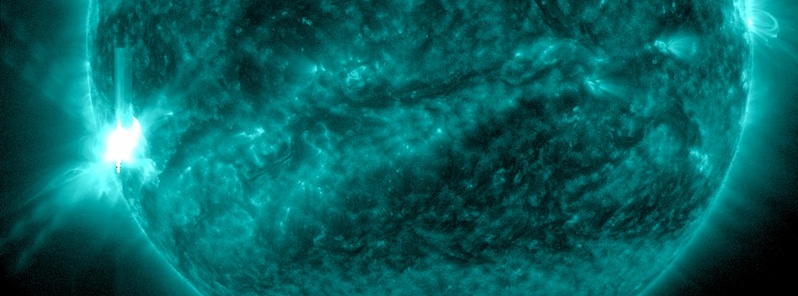Strong, long duration M9.2 solar flare erupts from Region 2297

Strong and long duration solar flare measuring M9.2 (R2 – Moderate) at its peak time erupted from Region 2297 at 22:22 UTC on March 7, 2015. The event started at 21:59 and ended at 22:49 UTC.
A Type II (estimated velocity 704 km/s) and Type IV radio sweeps were associated with the event. Type IV emissions occur in association with major eruptions on the Sun and are typically associated with strong Coronal Mass Ejections and solar radiation storms.
Additionally, a 10cm Radio Burst lasting 10 minutes (peak flux 260 sfu) was associated with the event. A 10cm radio burst indicates that the electromagnetic burst associated with a solar flare at the 10cm wavelength was double or greater than the initial 10cm radio background. This can be indicative of significant radio noise in association with a solar flare. This noise is generally short-lived but can cause interference for sensitive receivers including radar, GPS, and satellite communications.
Region 2297's proximity to the eastern limb still makes it difficult to accurately determine its sunspot classification and magnetic complexity.
SOHO LASCO C2 and C3 imagery observed a fast-moving, partial-halo CME off the ESE limb at 22:24 UTC and 23:06 UTC on March 7, respectively. Initial analysis and subsequent WSA-Enlil model output, using limited LASCO and STEREO-A imagery, indicated no Earth-impact at this time. As more imagery becomes available, further analysis will be accomplished, SWPC said.
Region 2297 appears to have rotated fully into view now (March 8) and indicated growth both in size and complexity.


Space Weather Message Code: ALTXMF
Serial Number: 250
Issue Time: 2015 Mar 07 2204 UTC
ALERT: X-Ray Flux exceeded M5
Threshold Reached: 2015 Mar 07 2203 UTC
NOAA Scale: R2 - Moderate
NOAA Space Weather Scale descriptions can be found at
www.swpc.noaa.gov/noaa-scales-explanation
Potential Impacts: Area of impact centered on sub-solar point on the sunlit side of Earth. Extent of blackout of HF (high frequency) radio communication dependent upon current X-ray Flux intensity. For real-time information on affected area and expected duration please see http://www.swpc.noaa.gov/products/d-region-absorption-predictions-d-rap.

Space Weather Message Code: ALTTP2
Serial Number: 995
Issue Time: 2015 Mar 07 2241 UTC
ALERT: Type II Radio Emission
Begin Time: 2015 Mar 07 2157 UTC
Estimated Velocity: 704 km/s
NOAA Space Weather Scale descriptions can be found at
www.swpc.noaa.gov/noaa-scales-explanation
Description: Type II emissions occur in association with eruptions on the sun and typically indicate a coronal mass ejection is associated with a flare event.
Space Weather Message Code: ALTTP4
Serial Number: 493
Issue Time: 2015 Mar 07 2242 UTC
ALERT: Type IV Radio Emission
Begin Time: 2015 Mar 07 2204 UTC
NOAA Space Weather Scale descriptions can be found at
www.swpc.noaa.gov/noaa-scales-explanation
Description: Type IV emissions occur in association with major eruptions on the sun and are typically associated with strong coronal mass ejections and solar radiation storms.
Space Weather Message Code: SUM10R
Serial Number: 654
Issue Time: 2015 Mar 07 2301 UTC
SUMMARY: 10cm Radio Burst
Begin Time: 2015 Mar 07 2236 UTC
Maximum Time: 2015 Mar 07 2239 UTC
End Time: 2015 Mar 07 2246 UTC
Duration: 10 minutes
Peak Flux: 260 sfu
Latest Penticton Noon Flux: 138 sfu
NOAA Space Weather Scale descriptions can be found at
www.swpc.noaa.gov/noaa-scales-explanation
Description: A 10cm radio burst indicates that the electromagnetic burst associated with a solar flare at the 10cm wavelength was double or greater than the initial 10cm radio background. This can be indicative of significant radio noise in association with a solar flare. This noise is generally short-lived but can cause interference for sensitive receivers including radar, GPS, and satellite communications.
Sunspots
There is currently 1 numbered sunspot region on the Earth side of the Sun.

Sunspots on March 7, 2015. Image credit: NASA SDO/HMI
2297 – Alpha (proximity to the eastern limb still makes it difficult to accurately determine its sunspot classification and magnetic complexity)
Forecast
Solar activity is expected to be low with a chance for M-class (R1-R2/Minor-Moderate) flare activity over the next three days (March 7 – 9) with Region 2297 being the likely source of subsequent flare activity, SWPC said in their Forecast Discussion at 12:30 UTC today.
The greater than 2 MeV electron flux is expected to be at normal to moderate levels over the next three days and the greater than 10 MeV proton flux is expected to persist at background levels for the same period.
Solar wind parameters are expected to become enhanced beginning today due to the influence of a co-rotating interaction region (CIR) in advance of coronal hole high speed stream (CH HSS) effects. Wind speeds are expected to increase to around 550-625 km/s on March 8 and 9 as the positive polarity CH HSS moves into geoeffective position.
The geomagnetic field is expected to be quiet to active on March 7 and 8 due to the onset of a CIR today followed by the influence of a positive polarity CH HSS tomorrow. Field activity is expected to be at unsettled to active levels March 9 as CH HSS influence continues.
Featured image: NASA SDO/AIA 131 at 22:15 UTC on March 7, 2015.

Commenting rules and guidelines
We value the thoughts and opinions of our readers and welcome healthy discussions on our website. In order to maintain a respectful and positive community, we ask that all commenters follow these rules.